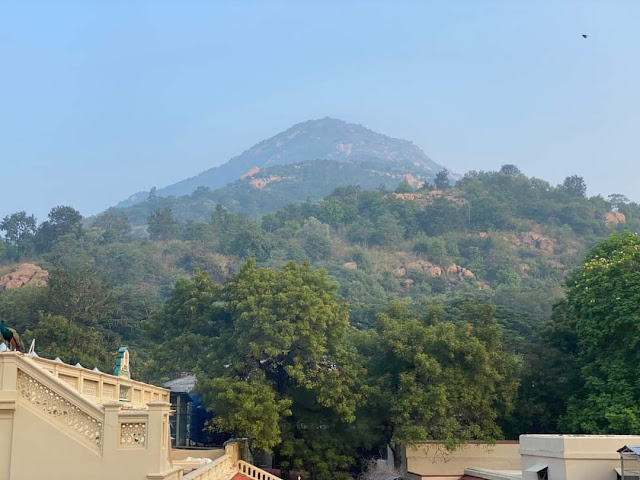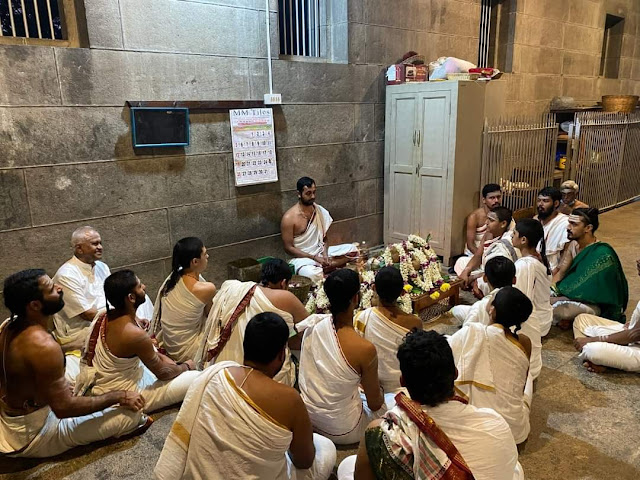The guru is Brahma, the guru is Vishnu, the guru is the Great God Shiva.
The guru is the Supreme Being right before one's very eyes.
To that guru do I reverently bow.
Guru Purnima Monday, 3 July, 2023
Guru Purnima is traditionally celebrated on full moon day in the month of Ashadh (July-August) of the Hindu calendar. Guru Purnima (which falls this year on Monday, July 3th) is the day on which the Guru is revered by devotees. Sri Dakshinamurti is an aspect of Lord Siva as the primordial master, the personification of ultimate awareness, understanding and knowledge.
 |
| Lord Siva as Arunachala |
At Arunachala the manifestation of Lord Siva as Dakshinamurti is celebrated as the ‘silent Guru’. This day also celebrates the birth of the great author Veda Vyasa who wrote the epic Mahabharata.
Guru Purnima Timing 2023
Tithi starts at 08:21 pm on July 2, Sunday
Tithi ends at 5.08 pm on July 3, Monday
Lord Siva and His Worship
During the absence of Devi, when Lord Siva was alone, the sons of Brahma, (sages: Sanaka, Sanandana, Sanatana and Sanatkumara) went to have Darshan of Lord Siva. They prostrated before Him and entreated the Lord to teach them how to remove avidya and attain salvation. They admitted that in spite of their vast study of scriptures they had no internal peace and needed to learn the inner secrets—by knowing which they could attain salvation.
 |
| Lord Dakshinamurti frescoe Madurai Temple |
"Lord Siva, hearing this appeal made by the sages, assumed the form of Dakshinamurti and remaining as the Guru Supreme, began to teach them the inner secrets by keeping Mouna and showing the “chinmudra” by His hand. The sages began to meditate on the lines shown by the Lord and attained the state of inexpressible and illimitable joy. Thus Lord Siva came to be known as Dakshinamurti".
[By Swami Sivananada]
Sri Ramana Maharshi on Dakshinamurti
Ramana Maharshi: Lectures may entertain individuals for a few hours without improving them. Silence on the other hand is permanent and benefits the whole of humanity.
Devotee: But silence is not understood.
Ramana Maharshi: It does not matter. By silence, eloquence is meant. Oral lectures are not so eloquent as silence. Silence is unceasing eloquence. The Primal Master, Dakshinamurti, is the ideal. He taught his Rishi disciples by silence.
Devotee: But then there were disciples for Him. It was all right. Now it is different. They must be sought after and helped.
Ramana Maharshi: That is a sign of ignorance. The power which created you has created the world. If it can take care of you, it can similarly take care of the world also.
[Talks with Sri Ramana Maharshi]
Devotee: What is the significance of Guru's Grace in the attainment of liberation?
Ramana Maharshi: Liberation is not anywhere outside you. It is only within. If a man is anxious for Deliverance, the Guru within pulls him in and the Guru without pushes him into the Self. This is the Grace of the Guru.
[Talks with Sri Ramana Maharshi: Talk 547)
Shiva: The Adiyogi
The sacred day of Guru Poornima marks the first transmission of the yogic sciences from Shiva—the Adiyogi or First Yogi—to the Saptarishis, the seven celebrated sages on the banks of Lake Kantisarovar (near Kedarnath Temple in the Himalayas). Thus, the Adiyogi became the Adi Guru or the First Guru on this day. The Saptarishis carried this knowing offered by Adiyogi throughout the world. Even today, every spiritual process on the planet draws from the "knowing" created by Adiyogi.
 |
| Adi Yogi |
The story goes that over 15,000 years ago, a yogi appeared in the upper regions of the Himalayas. Nobody knew what his origins were but his presence was extraordinary. He exhibited no signs of life, but for occasional tears of ecstasy that rolled down his face. After the crowds of onlookers dispersed, seven men remained. When the yogi opened his eyes, they pleaded that he share his experience with them. He ignored them, but as they persevered the yogi gave them a simple preparatory step and closed his eyes again.
Days rolled into weeks, weeks into months, months into years, but the yogi’s attention did not fall upon them again. After 84 years of sadhana, on the summer solstice that marks the advent of Dakshinayana (the earth’s southern run), the yogi looked at them again. They had become shining souls that could be no longer ignored. On the next full moon day, the yogi turned south and sat as guru to these seven men. Shiva thus became Adi Guru and expounded spiritual truths to the seven disciples. The seven were to be known as Saptarishis, who took their knowledge around the world.
Guru Purnima is held sacred in the yogic tradition because the Adiyogi opened up the possibility for a human being to evolve consciously. The seven different aspects of yoga that were put in these seven individuals became the foundation for the seven basic forms of yoga, something that has still endured.
In honour of this divine personage, spiritual aspirants and devotees either perform Vyasa Puja on this day, or worship their own spiritual preceptor. Saints, monks and men of God are honoured and entertained with acts of charity by householders with faith and sincerity. The period Chaturmas (the "four months") begins from this day; Sannyasins stay at one place during the ensuing four rainy months, engaging in the study of the Brahma Sutras and the practice of meditation.
The day of Guru Poornima is supposed to herald the settling in of the rains and is thus a time that aspirants commence or resolve to intensify their spiritual disciplines. The Srutis say: "To that high-souled aspirant, whose devotion to the Lord is great and whose devotion to his Guru is as great as that to the Lord, the secrets explained herein become illuminated".
Spiritual Teachings of the Sadguru
The upa-agama, Devilottara is the essence of all Agama Sastra and explains the supreme wisdom to be attained by mature souls and their mode of life, expounded by the Lord Siva to Devi.
 |
| Lord Siva with Parvati |
This dialogue conveys the highest spiritual teachings between the Sadguru Lord Siva and His most surrendered devotee the Goddess Parvati.
To read these teachings go to this link here.
























